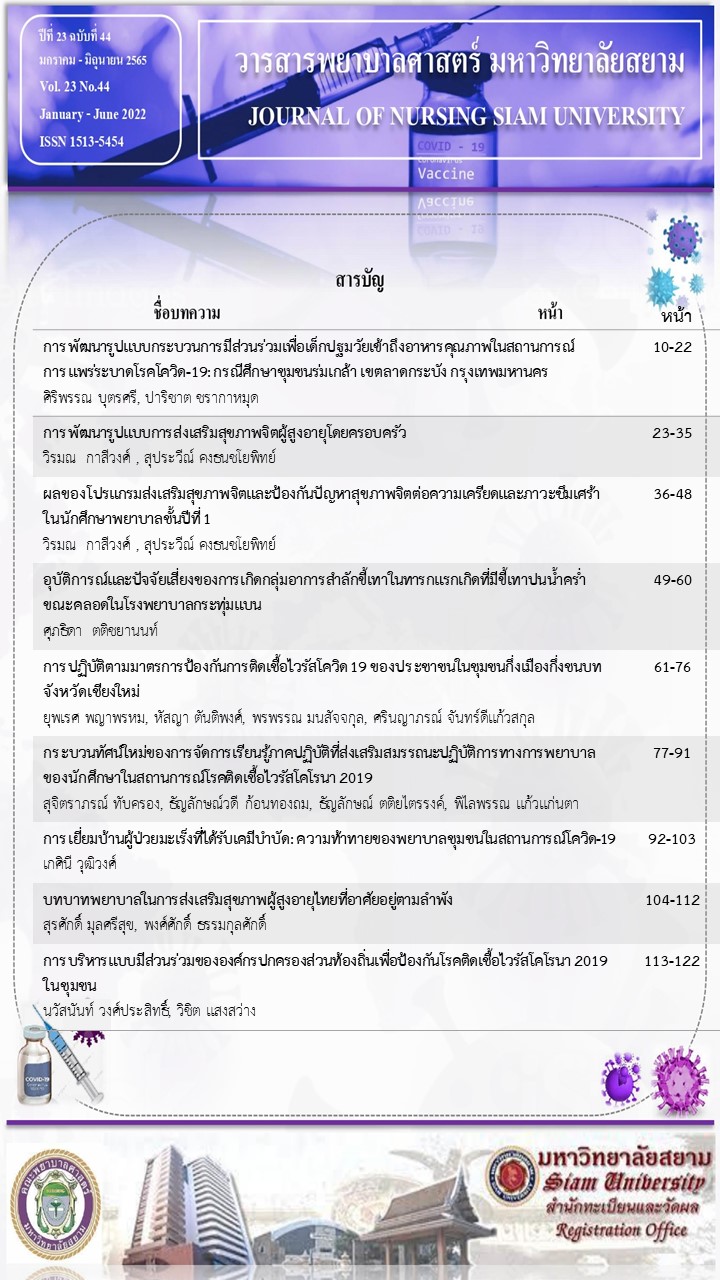การบริหารแบบมีส่วนร่วมขององค์กรปกครองส่วนท้องถิ่น เพื่อป้องกันโรคติดเชื้อไวรัสโคโรนา 2019 (Covid-19) ในชุมชน
คำสำคัญ:
การบริหารแบบมีส่วนร่วม, องค์กรปกครองส่วนท้องถิ่น, สถานการณ์โรคติดเชื้อไวรัสโคโรนา 2019บทคัดย่อ
การแพร่ระบาดโรคติดเชื้อไวรัสโคโรนา 2019 (COVID-19) พบครั้งแรกปลายปี 2562 ในนครอู่ฮั่น เมืองหลวงของมณฑลหูเป่ย์ ประเทศจีน สาเหตุที่เป็นไปได้มากที่สุด คือ การสัมผัสกับเนื้อสัตว์ที่วางขายในตลาด เมืองอู่ฮั่นเป็นเมืองใหญ่มีประชาชนอยู่หนาแน่น ส่งผลให้การระบาดกระจายไปทั่วโลกอย่างรวดเร็ว ทำให้มีผู้ป่วยและผู้เสียชีวิตจำนวนมาก องค์การอนามัย (The World Health Organization; WHO) ระบุว่า ไวรัสชนิดนี้ คือ SARS-CoV-2 เรียกว่า COVID-19 เป็นการแพร่เชื้อจากคนสู่คนผ่านละอองฝอยขนาดเล็ก (Aerosol) และประกาศเป็นภาวะฉุกเฉินทางสาธารณสุขระหว่างประเทศ ส่งผลกระทบต่อประชาชนทุกด้านเชื่อมโยงอย่างเป็นองค์รวม มาตรการป้องกันโรคเพื่อลดการระบาด คือ การเว้นระยะห่างทางสังคม การสวมหน้ากากอนามัย การล้างมือให้ถูกวิธี เมื่อติดเชื้อให้เข้ารับการรักษา หรือมีภาวะเสี่ยงต้องกักตัว ทำให้การดำรงชีวิตและการทำงานต่าง ๆ ต้องปรับตัว ประชาชนตกงานไม่มีรายได้ต้องกลับมาอยู่บ้าน ผู้บริหารท้องถิ่นต้องอาศัยการมีส่วนร่วมจากทุกภาคส่วนในชุมชน ดังนั้นการบริหารแบบมีส่วนร่วมเพื่อป้องกันโรคติดเชื้อไวรัสโคโรนา 2019 (Covid-19) ในชุมชน จึงมีความสำคัญและเป็นแนวทางในการบริหารแบบมีส่วนร่วมขององค์กรปกครองส่วนท้องถิ่นในการจัดการเพื่อป้องกันโรคติดเชื้อไวรัสโคโรนา 2019 (Covid-19) ให้ผู้บริหารท้องถิ่นและผู้นำชุมชนต่าง ๆ ได้นำไปพัฒนาต่อไป
เอกสารอ้างอิง
กรมควบคุมโรค. (2564). แนวทางการเฝ้าระวัง ป้องกันและควบคุมโรคติดเชื้อไวรัสโคโรนา 2019. กรุงเทพฯ:กองโรคติดต่อทั่วไป.
กวินลดา ธีระพันธ์พงศ์และ จุฑาทิพย์ นามม่อง. (2564). ปัจจัยที่มีความสัมพันธ์ต่อพฤติกรรมการป้องกันการติดเชื้อไวรัสโคโรนา 2019 (โควิด-19)ของพนักงานในโรงงานขนาดใหญ่แห่งหนึ่ง อำเภอกระทุ่มแบน จังหวัดสมุทรสาครหน้า. วารสารพยาบาลศาสตร์มหาวิทยาลัยสยาม, 22(43), 10-20.
กาญจนา ปัญญาธร, กฤษณา ทรัพย์สิริโสภา, กมลทิพย์ ตั้งหลักมั่นคง, วรรธนี ครองยุต. (2564). การมีส่วนร่วมของชุมชนในการป้องกันโรค COVID-19 บ้านหนองสวรรค์ ตำบลเชียงพิณ อำเภอเมือง จังหวัดอุดรธานี. วารสารวิทยาลัยพยาบาลพระปกเกล้า จันทบุรี, 32(1), 189 – 204.
ระนอง เกตุดาว, อัมพร เที่ยงตรงดี และภาสินี โทอินทร์. (2564). การพัฒนารูปแบบการเฝ้าระวัง ป้องกันและควบคุมโรคติดเชื้อไวรัสโคโรนา 2019 โรงพยาบาลส่งเสริมสุขภาพตำบล จังหวัดอุดรธานี - Udon Model COVID-19. วารสารวิชาการสาธารณสุข, 30(1), 53 – 61.
พิฐชญาณ์ ศิริสัมพันธ์. (2563). การบริหารความต่อเนื่องภายใต้สภาวะวิกฤตหรือเหตุการณ์ฉุกเฉินต่าง ๆ: กรณีศึกษาองค์การบริหารส่วนตำบลบ้านคลองสวน อำเภอพระสมุทรเจดีย์ จังหวัดสมุทรปราการ. วิทยานิพนธ์รัฐประศาสนศาสตรมหาบัณฑิต คณะรัฐศาสตร์ มหาวิทยาลัยรามคำแหง.
มหาวิทยาลัยมหิดล. (2563). ความรู้พื้นฐาน COVID-19. คณะแพทยศาสตร์โรงพยาบาลรามาธิบดี, กรุงเทพมหานคร.
สำนักอนามัยสิ่งแวดล้อม. (2563). คู่มือการดำเนินงานระบบปฏิบัติการอนามัยสิ่งแวดล้อม สำหรับองค์กรปกครองส่วนท้องถิ่นในสถานการณ์การระบาดของโรคโควิด-19. กรุงเทพฯ: บริษัทสามเจริญพาณิชย์ (กรุงเทพ) จำกัด.
Cohen, J.M. & Uphoff, N.T. (1979). Rural Developmen Participation: Concept and Measures for Project Design Implementation and Evaluation. Rural Development Committee Center for International Studies: Cornell University.
Creighton, J. L. (2005). The Public Participation Handbook: Making Better Decisions through Citizen involvement. San Francisco: Jossey Bass.
Panigrahi, SK, Majumdar,. Galhotra, S, Kadle, SC & John, AS. (2021). Community Based Management of COVID-19 as a Way Forward for Pandemic Response. Frontiers in Public Health.8, 1-5. doi:10.3389/fpubh.2020.589772
United Nation. (2009). Popular Participation as a Strategy for Promoting Community Level Action and Nation Development. Report of the Meeting for The Adhoc Group of Expert. New York: United Nation.
ดาวน์โหลด
เผยแพร่แล้ว
รูปแบบการอ้างอิง
ฉบับ
ประเภทบทความ
สัญญาอนุญาต
ลิขสิทธิ์ (c) 2022 วารสารพยาบาลศาสตร์ มหาวิทยาลัยสยาม

อนุญาตภายใต้เงื่อนไข Creative Commons Attribution-NonCommercial-NoDerivatives 4.0 International License.
เนื้อหาและข้อมูลที่เผยแพร่ในวารสารพยาบาลศาสตร์ มหาวิทยาลัยสยามถือเป็นข้อคิดเห็นและความรับผิดชอบของผู้นิพนธ์บทความโดยตรง
บทความ เนื้อหา ข้อมูล รูปภาพ ฯลฯ ที่ได้รับการเผยแพร่ในวารสารพยาบาลศาสตร์ มหาวิทยาลัยสยาม ถือเป็นลิขสิทธิ์ของวารสารพยาบาลศาสตร์ มหาวิทยาลัยสยาม หากบุคคลหรือหน่วยงานใดต้องการนำทั้งหมดหรือส่วนหนึ่งส่วนใดไปเผยแพร่หรือเพื่อกระทำการใด ๆ จะต้องอ้างอิงวารสารพยาบาลศาสตร์ มหาวิทยาลัยสยามทุกครั้ง



